Nagios的NSClient++插件配置
NSClinet++監(jiān)控Windows主機(jī)的nagios插件
創(chuàng)新互聯(lián)建站堅(jiān)持“要么做到,要么別承諾”的工作理念,服務(wù)領(lǐng)域包括:成都網(wǎng)站建設(shè)、網(wǎng)站制作、企業(yè)官網(wǎng)、英文網(wǎng)站、手機(jī)端網(wǎng)站、網(wǎng)站推廣等服務(wù),滿足客戶于互聯(lián)網(wǎng)時(shí)代的延平網(wǎng)站設(shè)計(jì)、移動(dòng)媒體設(shè)計(jì)的需求,幫助企業(yè)找到有效的互聯(lián)網(wǎng)解決方案。努力成為您成熟可靠的網(wǎng)絡(luò)建設(shè)合作伙伴!
下載地址:https://nsclient.org/nscp/downloads
下載NSClient++-xxx-Win32
我們這里下載的是NSClient++-0.3.9-Win32.msi
安裝NSClient++
雙擊程序安裝,前面都點(diǎn)下一步,從下面可以看出來NSClient集成了很多的插件NRPE、NSCA等都支持
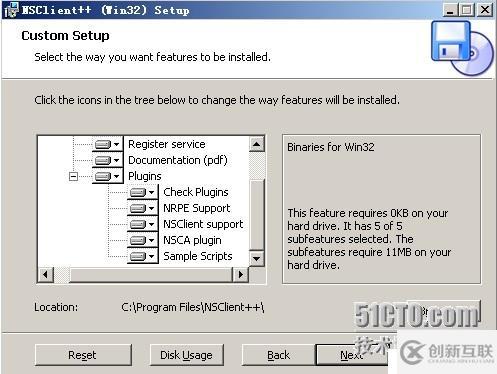
添加允許主機(jī)
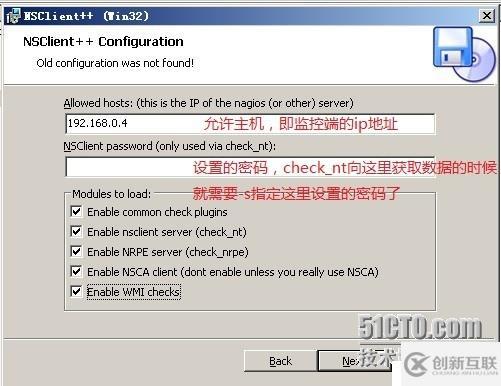
下面沒什么需要注意的了,直接下一步,安裝完成就可以了。
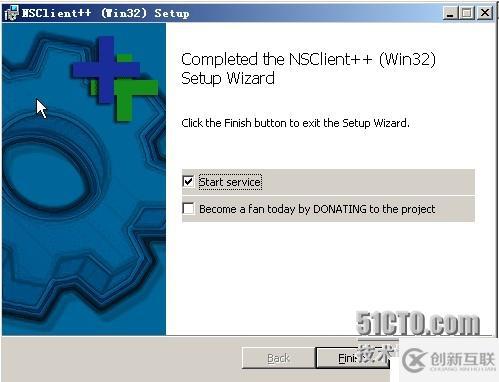
服務(wù)開啟以后可以看到服務(wù)端的端口開啟了,NSClient++使用的是12489端口,而且我們也看到nrpe的端口也開啟了
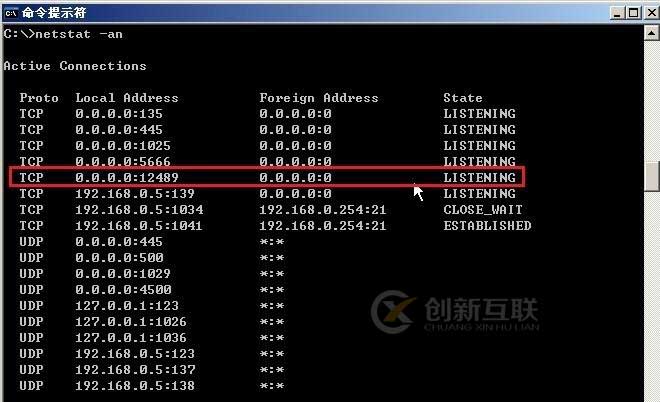
1、基于check_nt
Windows端安裝目錄下NSC.ini配置文件的要啟用的模塊:
[modules]
CheckSystem.dll
CheckDisk.dll
FileLogger.dll
NSClientListener.dll
[settings]
allowed_hosts =#允許的主機(jī)
Password= #密碼
修改配置后要重啟服務(wù):
nsclient++ /stop
nsclient++ /start
在nagios端使用如下命令測(cè)試:
check_nt -H <client ip> -p <port> -s <PASSWORD> -v <command> ...
# check_nt -H 172.16.100.66 -p 12489 -v CPULOAD -w 80 -c 90 -l5,80,90-s redhat
[root@node4 ~]# cd/usr/local/nagios/libexec/
[root@node4 libexec]#./check_nt -H 192.168.0.5 -p 12489 -v CPULOAD -w 80 -c 90 -l 5,80,90 -s redhat
CPU Load 0% (5 minaverage) | '5 min avgLoad'=0%;80;90;0;100
nagios端配置:
首先是命令配置:
[root@node4 ~]# cd/usr/local/nagios/etc/objects/
[root@node4 objects]#vim commands.cfg
define command{
command_name check_nt
command_line $USER1$/check_nt -H $HOSTADDRESS$ -p 12489-s redhat -v $ARG1$ $ARG2$
}
然后是主機(jī)配置:
# vim/usr/local/nagios/etc/objects/windows.cfg
define host{
use windows-server ; Inherit default values from a template
host_name winserver ; The name we're giving to this host
alias My Windows Server ; A longer name associated with the host
address 192.168.0.5 ; IP address of the host
}
###############################################################################
###############################################################################
#
# HOST GROUPDEFINITIONS
#
###############################################################################
###############################################################################
# Define a hostgroupfor Windows machines
# All hosts that usethe windows-server template will automatically be a member of this group
define hostgroup{
hostgroup_name windows-servers ; The name of the hostgroup
alias Windows Servers ; Long name of thegroup
}
###############################################################################
###############################################################################
#
# SERVICE DEFINITIONS
#
###############################################################################
###############################################################################
# Create a servicefor monitoring the version of NSCLient++ that is installed
# Change thehost_name to match the name of the host you defined above
define service{
use generic-service
host_name winserver
service_description NSClient++ Version
check_command check_nt!CLIENTVERSION
}
# Create a servicefor monitoring the uptime of the server
# Change thehost_name to match the name of the host you defined above
define service{
use generic-service
host_name winserver
service_description Uptime
check_command check_nt!UPTIME
}
# Create a servicefor monitoring CPU load
# Change thehost_name to match the name of the host you defined above
define service{
use generic-service
host_name winserver
service_description CPU Load
check_command check_nt!CPULOAD!-l 5,80,90
}
# Create a servicefor monitoring memory usage
# Change thehost_name to match the name of the host you defined above
define service{
use generic-service
host_name winserver
service_description Memory Usage
check_command check_nt!MEMUSE!-w 80 -c 90
}
# Create a servicefor monitoring C:\ disk usage
# Change thehost_name to match the name of the host you defined above
define service{
use generic-service
host_name winserver
service_description C:\ Drive Space
check_command check_nt!USEDDISKSPACE!-l c -w 80 -c90
}
# Create a servicefor monitoring the W3SVC service
# Change thehost_name to match the name of the host you defined above
define service{
use generic-service
host_name winserver
service_description W3SVC
check_command check_nt!SERVICESTATE!-d SHOWALL -lW3SVC
}
# Create a servicefor monitoring the Explorer.exe process
# Change thehost_name to match the name of the host you defined above
define service{
use generic-service
host_name winserver
service_description Explorer
check_command check_nt!PROCSTATE!-d SHOWALL -lExplorer.exe
}
在nagios配置文件內(nèi)添加一條cfg
[root@node4 objects]# vim/usr/local/nagios/etc/nagios.cfg
cfg_file=/usr/local/nagios/etc/objects/windows.cfg
做完上述的操作以后重啟nagios服務(wù)端的nagios服務(wù)
[root@node4 objects]#service nagios restart
Running configurationcheck...done.
Stopping nagios: done.
Starting nagios: done.然后在nagios的web管理界面上你就會(huì)發(fā)現(xiàn)一個(gè)新的主機(jī)

而且服務(wù)里面也多出很多我們定義的服務(wù)
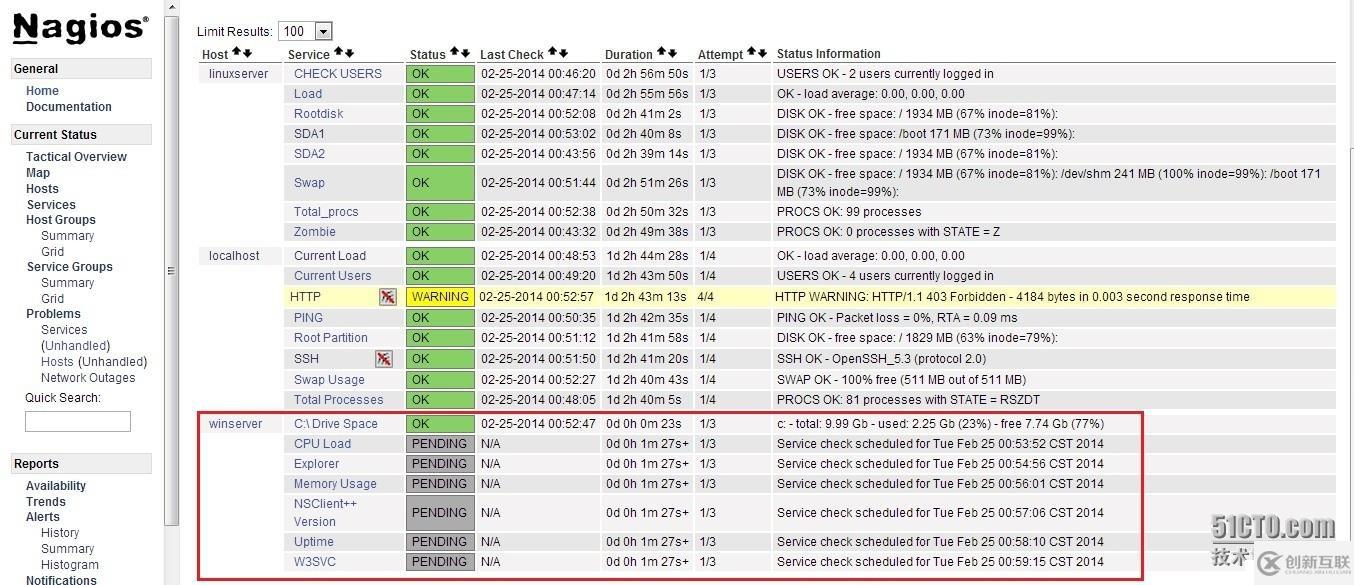
密碼保護(hù):
如果你在windows的機(jī)器上設(shè)置了密碼,你需要在commands.cfg配置文檔內(nèi)加上-s PASSWORD如下:
vi/usr/local/nagios/etc/objects/commands.cfg
define command{
command_name check_nt
command_line $USER1$/check_nt-H $HOSTADDRESS$ -p 12489-s PASSWORD -v $ARG1$$ARG2$
}
Save the file.
2、基于NRPE
Windows上NSClient++要啟用如下模塊:
[modules]
CheckSystem.dll
CheckDisk.dll
CheckExternalScripts.dll
FileLogger.dll
NRPEListener.dll
NRPE specific settingin NSClient++
use_ssl #使用ssl
allow_arguments #是否允許nagios服務(wù)端傳遞參數(shù)過來
allow_nasty_meta_chars #傳遞參數(shù)的時(shí)候是否可以包含一些&<>等字符
bind_to_address= #綁定在那個(gè)地址上,默認(rèn)監(jiān)聽在0.0.0.0
allowed_hosts= #允許主機(jī)
check_nrpe語(yǔ)法:
check_nrpe ... -c<command> [-a <argument> <argument> <argument>]
check_nrpe的內(nèi)置命令:
·CheckAlwaysCRITICAL (check)
·CheckAlwaysOK (check)
·CheckAlwaysWARNING (check)
· CheckCPU(check)
·CheckCRITICAL (check)
·CheckCounter (check)
·CheckEventLog/CheckEventLog (check)
·CheckFile (check)
·CheckFileSize (check)
· CheckMem(check)
·CheckMultiple (check)
· CheckOK(check)
·CheckProcState (check)
·CheckServiceState (check)
·CheckTaskSched/CheckTaskSched (check)
·CheckUpTime (check)
·CheckVersion (check)
·CheckWARNING (check)
·CheckWMI/CheckWMI (check)
·CheckWMIValue (check)
用法如:
# check_nrpe ... -cCheckCPU -a warn=80 crit=90 time=20m time=10s time=4
Nagios端的配置:
1) Template
define host{
nametpl-windows-servers
usegeneric-host
check_period24x7
check_interval5
retry_interval1
max_check_attempts10
check_commandcheck-host-alive
notification_period24x7
notification_interval30
notification_optionsd,r
contact_groupsadmins
register0
}
2) 定義主機(jī):
define host{
usetpl-windows-servers
host_namewindowshost
aliasMy First Windows Server
address172.16.100.66
}
3) 定義服務(wù):
define service{
usegeneric-service
host_namewindowshost
service_descriptionCPU Load
check_commandcheck_nrpe!alias_cpu
}
define service{
usegeneric-service
host_namewindowshost
service_descriptionFree Space
check_commandcheck_nrpe!alias_disk
}
3、基于NSCA
[modules]
CheckSystem.dll
CheckDisk.dll
CheckExternalScripts.dll
CheckHelpers.dll
FileLogger.dll
NSCAAgent.dll
NSClient++配置
interval
encryption_method
password
nsca_host
修改配置后要重啟服務(wù)
1) 模板
define host{
nametpl-windows-servers ; Name of this template
usegeneric-host ; Inherit default values
check_period24x7
check_interval5
retry_interval1
max_check_attempts10
check_commandcheck-host-alive
notification_period24x7
notification_interval30
notification_optionsd,r
contact_groupsadmins
register0 ; DONT REGISTER THIS - ITS A TEMPLATE
}
2)主機(jī)配置
define host{
usetpl-windows-servers
host_namewindowshost
aliasMy First Windows Server
address172.16.100.66
active_checks_enabled0
passive_checks_enabled1
}
3)服務(wù)配置
define service{
usegeneric-service
host_namewindowshost
service_descriptionCPU Load
check_commandcheck_nrpe!alias_cpu
active_checks_enabled0
passive_checks_enabled1
}
define service{
usegeneric-service
host_namewindowshost
service_descriptionFree Space
check_commandcheck_nrpe!alias_disk
active_checks_enabled0
passive_checks_enabled1
}
文章名稱:Nagios的NSClient++插件配置
路徑分享:http://chinadenli.net/article6/ihpcog.html
成都網(wǎng)站建設(shè)公司_創(chuàng)新互聯(lián),為您提供靜態(tài)網(wǎng)站、ChatGPT、動(dòng)態(tài)網(wǎng)站、Google、品牌網(wǎng)站制作、面包屑導(dǎo)航
聲明:本網(wǎng)站發(fā)布的內(nèi)容(圖片、視頻和文字)以用戶投稿、用戶轉(zhuǎn)載內(nèi)容為主,如果涉及侵權(quán)請(qǐng)盡快告知,我們將會(huì)在第一時(shí)間刪除。文章觀點(diǎn)不代表本網(wǎng)站立場(chǎng),如需處理請(qǐng)聯(lián)系客服。電話:028-86922220;郵箱:631063699@qq.com。內(nèi)容未經(jīng)允許不得轉(zhuǎn)載,或轉(zhuǎn)載時(shí)需注明來源: 創(chuàng)新互聯(lián)

移動(dòng)網(wǎng)站建設(shè)知識(shí)
- 百度移動(dòng)搜索:移動(dòng)網(wǎng)站建設(shè)常見問題集錦 2022-02-22
- 跨平臺(tái)移動(dòng)網(wǎng)站建設(shè)開發(fā)框架介紹 2023-02-26
- ?進(jìn)行移動(dòng)網(wǎng)站建設(shè)有什么益處及重要性分析 2023-03-15
- 創(chuàng)新互聯(lián)網(wǎng)站建設(shè)步入移動(dòng)網(wǎng)站建設(shè)行業(yè) 2021-12-19
- 移動(dòng)網(wǎng)站建設(shè)需要注意哪些細(xì)節(jié) 2017-07-03
- 移動(dòng)網(wǎng)站建設(shè)成功與失敗的決定性因素有哪些? 2017-01-25
- 移動(dòng)網(wǎng)站建設(shè)時(shí)需要注意什么? 2016-08-07
- 移動(dòng)網(wǎng)站建設(shè)的好處 2016-11-08
- 移動(dòng)網(wǎng)站建設(shè)需要避免哪些陷阱 2016-08-25
- 移動(dòng)網(wǎng)站建設(shè)有什么作用? 2023-03-11
- 如何從用戶角度進(jìn)行移動(dòng)網(wǎng)站建設(shè)? 2023-02-14
- 移動(dòng)網(wǎng)站建設(shè)需要多少錢? 2022-12-30